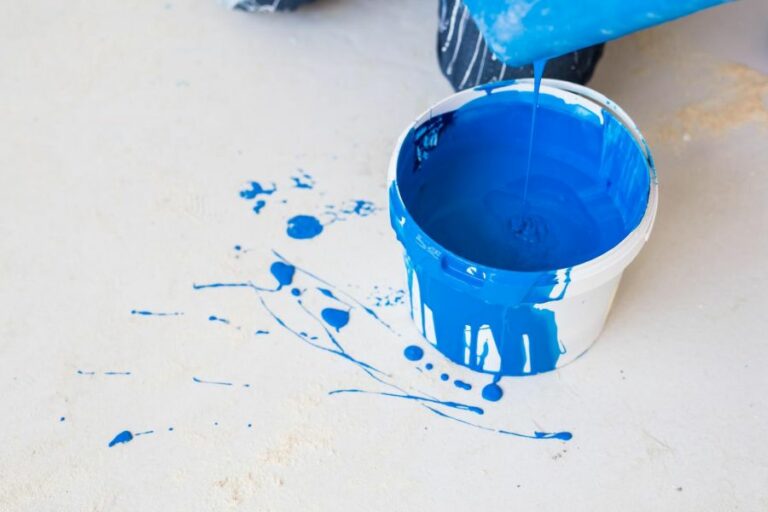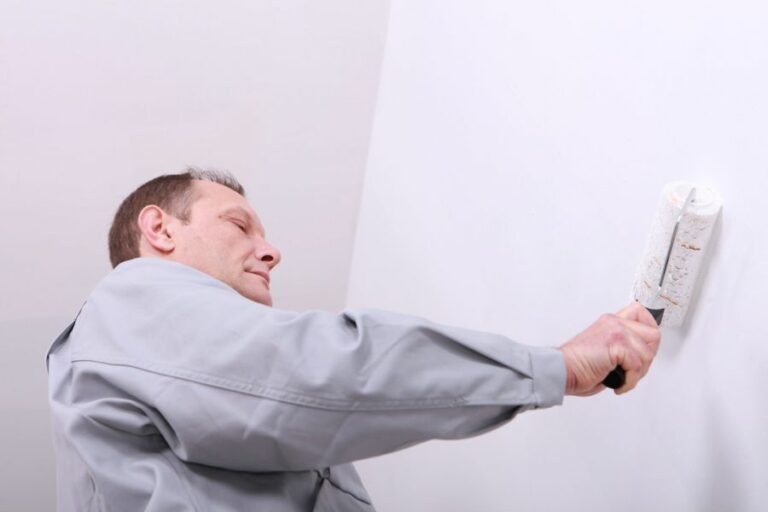Oil-Based Indoor Paint Options, 25 Things You Should Know
Are you considering a new interior paint job and weighing your options for the perfect finish? I will guide you through the various oil-based indoor paint options available. Possessing a wealth of knowledge and expertise in this area, I am confident that my recommendations will result in an impeccable and long-lasting paint job tailored to your needs.
Oil-based indoor paint options:
Oil-based indoor paint options offer durability, stain resistance, and a smooth, glossy finish, ideal for high-traffic areas and spill-prone rooms. Popular types include alkyd, enamel, textured, and rust-inhibiting paints, suitable for wood, metal, and surfaces requiring depth or rust prevention. Proper tools and techniques ensure smooth application and a professional, lasting finish.

Discover the benefits and features of oil-based indoor paints! I’ll provide a comprehensive overview of the top options available, pros and cons, and helpful tips to make the right choice for your home. Read on and unlock the potential of oil-based wonders!
Contents
- 1 Indoor Oil-Based Paint Choices
- 2 Latex vs. Oil-Based Paint: Which is Best for Interior Trim?
- 3 Top Oil-Based Paint Brands to Consider
- 4 Advantages of Oil-Based Paint for Interior Projects
- 5 Availability of Oil-Based Paint Today
Indoor Oil-Based Paint Choices
When selecting paint for your home, oil-based indoor paint offers various advantages.
• Benefits of Oil-Based Paints
– Durability and Longevity
The most significant advantage of oil-based paints is their durability. These paints can withstand more wear and tear compared to water-based paints, making them ideal for high-traffic areas such as hallways, kitchens, and bathrooms.
Oil-based paints are also resistant to moisture, which helps prevent peeling and flaking over time.
– Smooth and Glossy Finish
Oil-based paints often dry to a smooth, glossy finish that can give a professional and polished appearance to your rooms. The gloss level can be regulated depending on the product, providing options for semi-gloss, satin, or high-gloss finishes.
– Stain Resistance
Oil-based paints are more resistant to staining than water-based paints, making them a great option for rooms prone to spills, splatters, or other messes. They are also easier to clean, allowing you to maintain the appearance of your walls with simple soap and water.
• Types of Oil-Based Indoor Paints
There are various types of oil-based indoor paint available, each with unique qualities and benefits. Some popular options include:
– Alkyd Paints
Alkyd paints are a popular choice due to their ease of application and rapid drying times. These paints are made from modified oil and resin binders, providing excellent adhesion properties and a smooth finish.
Alkyd paint is suitable for wood surfaces, cabinetry, doors, and trim. This article from Fine Homebuilding provides information on the differences between alkyd and latex paints.
– Enamel Paints
Enamel paints are often used on wood and metal surfaces, as they give a hard, durable finish that is resistant to chipping and scratching. Available in a variety of sheens, enamel paint can be custom-tinted to achieve the perfect color for your project.
– Textured Paints
For homeowners looking to add depth and character to their walls, textured oil-based paint is an excellent choice. These paints can be used to create a variety of finishes, including stippling, sand-textured, or popcorn effects.
– Rust-Inhibiting Paints
If you are dealing with a room that contains metal surfaces, rust-inhibiting paint can be an ideal option. This paint contains a blend of resins, oils, and additives that form a barrier between the metal and moisture to prevent rust from forming.
• Necessary Tools and Techniques for Applying Oil-Based Paints
Using oil-based paint indoors requires the proper tools and techniques to achieve smooth, professional results.
– Tools
- High-quality paintbrushes, rollers, or a sprayer, depending on your preferred application method
- Mineral spirits or paint thinner to clean brushes and rollers
- A good-quality primer suited for use with oil-based paint
- Painter’s tape to protect surfaces from unintentional paint application
- Drop cloths to safeguard floors and furniture from drips and spills
– Techniques
- Ensure that the surfaces to be painted are clean, dry, and free of dust and debris
- Apply primer, giving it adequate time to dry according to the manufacturer’s recommendations
- Stir the paint thoroughly before applying it to avoid color variation
- Apply multiple thin coats of paint, allowing each coat to dry before applying the next
- Ventilate the room during painting, as oil-based paints can emit strong odors
• Conclusion
Oil-based indoor paint options are a versatile and durable choice for many homeowners. By considering the benefits, types, and appropriate application methods, you can achieve a professional, lasting finish that enhances the beauty of your home.
Latex vs. Oil-Based Paint: Which is Best for Interior Trim?
Painting your interior trim can give your home a fresh and polished look. However, when choosing the paint, it can be confusing whether to use latex or oil-based paint. Both types have their advantages and disadvantages.
• Understanding Latex Paint
Latex paint, also known as water-based paint, is popular for its eco-friendly and user-friendly properties. Its main components are water, acrylic, and vinyl resins. Latex paint is known for its quick drying time, easy clean-up, and low odor.
– Advantages of Latex Paint
- Easy Application and Cleanup: Unlike oil-based paint, latex paint is easy to apply and clean up after. If you make a mistake or spill paint on unwanted areas, you can quickly clean it up using water and soap.
- Quick Drying Time: Latex paint dries faster than oil-based paint, making it a popular choice for those looking to finish their project quickly.
- Low VOCs and Odor: Latex paint has lower volatile organic compounds (VOCs) according to the Environmental Protection Agency (EPA), making it a healthier choice for you and the environment. Its low odor also makes it more pleasant to work with.
- Flexibility and Resistance to Peeling: Latex paint is more flexible than oil-based paint, making it more resistant to peeling and cracking over time.
- Longevity: Newer latex paint formulations are more resistant to yellowing and maintain their color for a longer time than oil-based paint.
– Disadvantages of Latex Paint
- Lower Durability: Latex paint is generally not as durable as oil-based paint, making it more susceptible to wear and tear.
- Less Adhesion: Latex paint does not adhere as well to surfaces as oil-based paint, especially when applied to previously painted surfaces.
• Understanding Oil-Based Paint
Oil-based paint, also known as alkyd paint, consists of pigments suspended in a binder made of natural or synthetic oils. These paints are known for their durability, shine, and strong adhesion.
– Advantages of Oil-Based Paint
- Durability: One of the main benefits of oil-based paint is its durability. It is more resistant to wear, making it suitable for high-traffic areas and surfaces that are touched frequently.
- Smooth, High-Gloss Finish: Oil-based paint typically produces a smooth, high-gloss finish, making it a popular choice for trim and molding.
- Strong Adhesion: Oil-based paint adheres well to surfaces, making it an ideal choice for surfaces that have been previously painted with oil-based paints.
– Disadvantages of Oil-Based Paint
- Longer Drying Time: Oil-based paint takes longer to dry, often requiring overnight drying, which may slow down your project.
- Cleanup Challenges: Cleanup can be more challenging with oil-based paint since it requires the use of harsh chemicals or solvents.
- Higher VOCs and Odor: Oil-based paint has higher levels of VOCs, which can be harmful to your health and the environment. The strong odor may also be unpleasant to work with, and sufficient ventilation is essential.
- Yellowing and Fading: Oil-based paint is more prone to yellowing over time, especially if it is not exposed to sunlight. This can negatively affect the appearance of the painted trim.
• Making the decision: Latex or Oil-Based Paint for Interior Trim
When it comes to choosing between latex and oil-based paint for your interior trim, consider your specific needs, preferences, and priorities.
- If you need a durable, high-gloss finish and strong adhesion, oil-based paint might be the better choice for you. However, be prepared for longer drying times, challenging cleanups, and strong odors.
- If you prioritize quick drying times, easy cleanup, and low VOCs and odor, go for latex paint. While it may not be as durable as oil-based paint, advancements in latex paint formulations have improved their durability and resistance to yellowing.
In conclusion, there is no one-size-fits-all answer to whether latex or oil-based paint is better for your interior trim. Carefully consider the factors discussed in this article, and make the choice that best suits your needs and preferences to achieve the desired results for your interior trim painting project.
Top Oil-Based Paint Brands to Consider
If you are considering using oil-based paint for your next project, its important to choose the right brand for the best results. This article will discuss some of the top oil-based paint brands available in the market and the unique features they offer. Moreover, it will provide recommendations based on personal experience.
• Sherwin-Williams
One of the most renowned paint manufacturers is Sherwin-Williams. For over 150 years, this American company has been producing premium-quality paints and coatings for both residential and commercial use. Among their popular oil-based paint products, we find:
- Pro Industrial Urethane Alkyd Enamel: This enamel provides excellent coverage and durability, making it an ideal choice for industrial environments with heavy traffic.
- ProMar Alkyd Industrial Enamel: Best suited for commercial spaces, this enamel offers excellent durability and weather resistance.
Recommendation: As a long-time user, I highly recommend the Pro Industrial Urethane Alkyd Enamel for its superior performance.
Learn more about Sherwin-Williams products here.
• Benjamin Moore
Benjamin Moore is another well-respected brand known for their commitment to innovation and sustainability. Some of their important oil-based paint products include:
- Satin Impervo Alkyd Low Lustre Paint: This product offers superior flow and leveling for a smooth finish, making it ideal for trim and doors.
- Advance Interior Alkyd Paint: With its self-leveling properties, low VOC content, and excellent durability, this paint is a popular choice for interior surfaces.
Recommendation: Satin Impervo Alkyd Low Lustre Paint is my go-to option for trim and doors, as it never fails to provide a professional-looking finish.
Explore Benjamin Moore’s product range here.
• Rust-Oleum
Rust-Oleum is a brand synonymous with heavy-duty performance and exceptional durability. Their oil-based paint products are best suited for heavy wear, and outdoor applications include:
- Protective Enamel Paint: This enamel paint offers excellent rust resistance and durability, perfect for outdoor surfaces exposed to harsh weather conditions.
- High-Performance Enamel Spray Paint: This paint provides heavy-duty protection and a smooth finish for outdoor surfaces while also being available in a wide range of colors.
Recommendation: Personally, Rust-Oleum’s Protective Enamel Paint has always been the top choice for painting metal surfaces that need protection against rust.
Check out Rust-Oleum’s offerings here.
• Behr
With more than 70 years of experience, Behr is a household name in the paint industry. Their oil-based paint products include:
- Alkyd Satin Enamel: This product is ideal for indoor surfaces such as cabinets and trim, providing an easy-to-clean, durable finish.
- Alkyd Semi-Gloss Enamel: Offering a slightly shinier finish, this product is perfect for doors and other surfaces that need extra protection.
Recommendation: Based on personal experience, Behr’s Alkyd Satin Enamel is an excellent choice for interior projects, especially when painting kitchen cabinets.
Discover Behr’s product catalog here.
• PPG
PPG, Pittsburgh Paints & Stains, is a global supplier of high-quality paint products for both residential and commercial applications. Notable oil-based paint products from PPG include:
- Aquacron 200: Designed for metal surfaces, this enamel paint offers excellent corrosion protection and exceptional adhesion.
- DEFT Interior Clear Brushing Lacquer: This lacquer provides a durable, protective finish for interior wood surfaces.
Recommendation: PPG’s Aquacron 200 has been my preferred choice for metal applications requiring long-term rust protection.
You can learn more about PPGs products through their official website.
• Valspar
Valspar is another name in the paint industry that boasts more than 200 years of experience. While they are more known for their latex and water-based products, they also offer oil-based options, such as:
- Valspar Anti-Rust Armor: This anti-rust paint comes in different sheens and offers excellent protection against rust for indoor and outdoor metal surfaces.
- Valspar Medallion Exterior Paint: It is the perfect choice for exterior wood surfaces, providing resistance against weather, mildew, and UV damage.
Recommendation: In my experience, Valspar’s Anti-Rust Armor has always worked efficiently in preventing corrosion on metal surfaces.
Visit Valspars official website to know more about their products.
• Final Thoughts
Given the numerous oil-based paint brands available in the market, it’s essential to choose the one that best suits your requirements. Hopefully, this guide has provided you with valuable insights into some of the top brands and their unique offerings.
Remember that product performance may vary depending on factors like application technique, surface condition, and environmental factors. Always follow the manufacturer’s instructions for the best results.
Advantages of Oil-Based Paint for Interior Projects
When it comes to painting the interior of your home, you may find yourself wondering which type of paint is best for the job – oil or water-based paint? The advantages and disadvantages of each type can make this decision a challenging one.
• Durability and Hard Finish
One of the main benefits of using oil-based paint for interior applications is its durability. Oil-based paints are known for their hard, long-lasting finish that can withstand moisture, stains, and daily wear and tear.
This makes them an excellent choice for high-traffic areas such as kitchens, bathrooms, and hallways, where durability is crucial. Based on personal experience, oil-based paint can last up to 10-15 years, making it a worthwhile investment for ensuring a long-lasting finish.
• Smoothness and Self-Leveling Properties
Unlike water-based paints, oil-based paints offer a smoother finish as they are less prone to visible brushstrokes. This is due to the paint’s slow drying time, which allows the paint to settle and level itself on the surface, resulting in a more professional-looking finish.
For those looking for a flawless paint job, oil-based paint can provide superior smoothness and an even coat.
• Rich Colors and Superior Hide
Oil-based paint is known for its rich and vibrant colors, making it an excellent choice for those looking to make a bold statement in their interior spaces. It provides great coverage and effectively hides any imperfections on the surface of the wall or ceiling, resulting in fewer coats needed for full coverage.
This can save time and effort during the painting process, making oil-based paint a smart choice for achieving the desired look with fewer applications.
• Ideal for Wood and Metal Surfaces
Oil-based paint is highly recommended for use on wood and metal surfaces as it bonds well and provides a protective barrier against moisture and damage. This can help prevent issues such as warping, rust, and discoloration, prolonging the life of these materials.
Additionally, the hard finish provided by oil-based paint is less prone to chipping and scratching, ensuring that these surfaces remain in good condition for an extended period of time.
• Tips for Using Oil-Based Paint in Interior Spaces
While oil-based paint has numerous advantages, it is essential to keep certain factors in mind when working with this type of paint to achieve the best results.
– Ventilation and Drying Time
One downside of using oil-based paint indoors is the strong odor and fumes it emits during application and drying. It is crucial to ensure proper ventilation during and after painting to eliminate these fumes and facilitate quicker drying.
Additionally, oil-based paint takes longer to dry than water-based options, so it is important to factor in extra time for the paint to fully cure before returning items to the space or using the area.
– Clean Up and Disposal
Cleaning brushes and equipment used with oil-based paint require the use of solvents such as mineral spirits or paint thinner. This can make the cleaning process more cumbersome in comparison to water-based paint, which can be cleaned with soap and water.
Proper disposal of these solvents and any leftover paint is essential to prevent environmental harm and adhere to local disposal regulations.
– Application Techniques and Tools
Using the right tools and techniques can make all the difference when working with oil-based paint. A high-quality natural bristle brush or a roller with a solvent-resistant cover is recommended for smooth and even application.
It is also essential to thoroughly mix the paint before use and maintain a wet edge during application to prevent visible lap marks.
For more information on oil-based paint and best practices for using it in interior spaces, visit the U.S. Environmental Protection Agency (EPA) website, which offers guidelines and regulations on various types of paint and their application.
• Final Thoughts
In conclusion, while oil-based paint may not be suitable for every interior painting project, it has several distinct advantages, including durability, smoothness, rich colors, and suitability for wood and metal surfaces.
Considering these factors, personal preferences, and specific project requirements can help determine whether oil-based paint is the best choice for your interior painting needs.
By following the recommended tips and techniques when working with this type of paint, you can achieve a long-lasting and professional-quality finish in your home.
Availability of Oil-Based Paint Today
The simple answer to the question, “Is oil-based paint still available?” is yes. Oil-based paint still exists in the market, and it serves a specific set of purposes for various painting tasks.
• The Persistence of Oil-Based Paint
While water-based paints have surged in popularity due to their lower environmental impact and easier cleanup, there is still a demand for oil-based paints.
These paints offer unique qualities that make them suitable for specific applications and continue to appeal to both professional painters and do-it-yourself enthusiasts.
– Advantages of Oil-Based Paint
Oil-based paint has a few advantages that make it a desirable option for some projects:
- Durability: Oil-based paint is known for its long-lasting and hard-wearing finish, making it ideal for high-traffic and heavy-use areas.
- Adhesion: This type of paint has superior adhesion properties, allowing it to stick to surfaces more effectively than water-based paints, even on previously painted or primed surfaces.
- Gloss Retention: Oil-based paints tend to maintain their glossy finish for a longer period, making them suitable when a shiny finish is desired.
- Smooth and Uniform Application: Oil-based paints generally provide a smoother finish, with fewer visible brush marks, making them a popular choice for doors, cabinets, and trim work.
– Common Uses of Oil-Based Paint
Some applications where using oil-based paint may be desirable include:
- Doors and window trims
- Cabinets and furniture
- Metal surfaces (such as wrought iron or steel)
- Exterior surfaces exposed to harsh weather conditions
- Floors requiring heavy-duty protection
• Environmental Concerns and Regulation
It is important to acknowledge that oil-based paint is not without its drawbacks, especially when it comes to environmental impact. The primary concern is the presence of volatile organic compounds (VOCs), which contribute to air pollution and can pose health risks to humans.
In response to these concerns, regulations have been put in place to limit the number of VOCs in paints. This has led to a reduction in the number of oil-based paint products available on the market.
Additionally, many manufacturers have reformulated their products to be more environmentally friendly and adhere to government regulations.
For more information on VOCs and paint regulations, visit the United States Environmental Protection Agency website here.
• Precautions and Recommendations When Using Oil-Based Paint
With concerns over the environmental impact of oil-based paint and the continued existence of these products, it is important to take appropriate precautions and make informed choices when deciding to use oil-based paint.
- Ventilation: Ensure proper ventilation when using oil-based paint by opening doors and windows or using fans to promote airflow. This helps to reduce the concentration of VOCs in the air and mitigate health risks.
- Protective Gear: Use gloves, goggles, and a mask when working with oil-based paint to minimize exposure to harmful fumes and chemicals.
- Disposal: Properly dispose of oil-based paint and its containers according to local regulations. Many communities offer hazardous waste disposal programs for safe and responsible disposal.
- Alternatives: Consider using water-based paints or other environmentally-friendly alternatives, especially in cases where oil-based paint may not be necessary or advantageous.
- Low-VOC Oil-Based Paints: If an oil-based paint is necessary for your project, choose a product with a lower VOC content to minimize environmental impact. Always read the label and follow the manufacturer’s instructions for safe use.
• In Conclusion
Oil-based paint is still available, and it offers specific benefits such as durability, adhesion, and smoother finishes. However, concerns about its environmental impact have led to stricter regulations and a reduction in availability.
Always exercise caution when using oil-based paint, adhering to proper ventilation and protective procedures. Lastly, consider choosing eco-friendly alternatives or low-VOC oil-based paints whenever possible.







